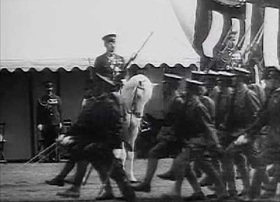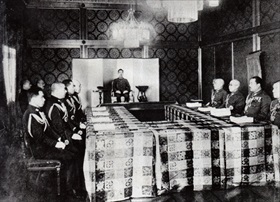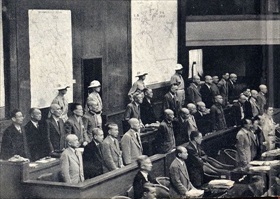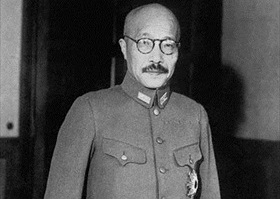HIROHITO SANCTIONS WAR WITH U.S.
Tokyo, Japan • November 5, 1941
On September 6, 1941, Japanese officials, in a decision endorsed by Shōwa Emperor Hirohito, gave their diplomats until mid-October to reverse the policy of the Western powers—principally the U.S., Great Britain, and the Netherlands—of restricting Japan’s access to vital Southeast Asian resources, among them oil, rubber, tin, bauxite, timber, and rice. The restrictions had been imposed by the West the previous month after Japan had stationed troops in Vichy French Indochina with the agreement of the German collaborationist government of Marshal Philippe Pétain. For its part, the U.S. had frozen Japanese assets in the U.S. and embargoed oil and gasoline exports to Japan. Unable to extricate himself from the decision of the previous month, Prime Minister Fumimaro Konoe resigned his office on October 16 when the Japanese Army and Navy high commands, over whom Konoe, a civilian, had no authority, pressed him to take action when the mid-October deadline for going to war with the West arrived.
At an Imperial Conference of Japanese officials (Gozen Kaigi) attended by Emperor Hirohito on this date, November 5, 1941, Gen. Hideki Tōjō—war minister, home minister, and since the resignation of Fumimaro Konoe Japan’s prime minister as well—said the country must be prepared to go to war with the West, with the time for military action tentatively reset for December 1 if diplomacy with the U.S. and European colonial powers failed to improve relations and reverse trade sanctions. The Japanese foreign minister didn’t see that happening, telling the august assembly that the prospects for diplomatic success were, “we most deeply regret, dim.” Even the emperor was aware twenty days earlier, when he appointed the warhawk Tōjō to the top cabinet position, that he just might have gambled away peace if this final attempt at negotiations in Washington failed.
Hirohito, who two days earlier had been briefed about his country’s planned attack on U.S. military installations at Pearl Harbor, Hawaii, readily assented to the operations plan for war against the Western nations. He held meetings with Tōjō and the military leadership until the end of November. Meanwhile the Japanese Diet (parliament) approved a resolution of hostility against the U.S. Late that month Kichisaburō Nomura, Japan’s ambassador to Washington, failed to overcome President Franklin D. Roosevelt’s insistence that Japan must withdraw from China and stop its aggressive Southeast Asian incursions before the U.S. would resume trade with his country.
On December 1 another Imperial Conference officially sanctioned war against the United States, Great Britain, and the Netherlands. Continued talks in Washington to heal the breach between the two nations were a smokescreen for Vice-Adm. Chūichi Nagumo’s Striking Force (Kido Butai) of six aircraft carriers as they made their way to the Hawaiian Islands by a little-used route and took up positions on December 4, 1941, 250 miles northwest of their designated targets—namely, the U.S. Pacific Fleet riding at anchor at Pearl Harbor and U.S. aircraft parked smartly at Hickman Field.
![]()
![]()
Emperor Hirohito and His Wartime Prime Minister, Gen. Hideki Tōjō
 |  |
Left: Soldiers parade before Shōwa Emperor Hirohito, a revered symbol of divine being (shinkaku). While perpetuating a cult of religious emperor worship, Hirohito also burnished his image as a warrior in photos and newsreels riding Shirayuki (White Snow), his beautiful white stallion. One news agency reported that Hirohito made 344 appearances on Shirayuki.
![]()
Right: Wartime photograph of Hirohito, seated in middle, as presiding head of the Imperial Conference (Gozen Kaigi). Convened by the Japanese government in the presence of the Emperor, the Imperial Conference was an extraconstitutional conference that focused on foreign affairs of grave national importance. Hirohito was also a member of the Imperial General Headquarters-Government Liaison Conference. Liaison Conferences coordinated the wartime efforts between the Imperial Japanese Army and Imperial Japanese Navy. In terms of function, there were roughly equivalent to the U.S. Joint Chiefs of Staff. Final decisions of Liaison Conferences were formally disclosed and approved at Imperial Conferences.
 |  |
Left: Defendants at the International Military Tribunal for the Far East (1946–1948). Gen. Hideki Tōjō (1884–1948), former war minister and prime minister of Japan, is fifth from left in first row of the defendants’ dock. Alluding to Emperor Hirohito’s success in dodging indictment as a war criminal, Judge Henri Bernard of France concluded that the war in the East “had a principal author who escaped all prosecution and of whom in any case the present Defendants could only be considered as accomplices.”
![]()
Right: Tōjō in military uniform. On July 22, 1940, Tōjō was appointed Army Minister. As spokesman for the Japanese Army high command, Tōjō was the leading advocate of war in the cabinets in which he served, and was instrumental in forcing Prime Minister Konoe’s resignation. During most of the Pacific War, from October 17, 1941 to July 22, 1944, Tōjō served in the post of prime minister. In that capacity he was directly responsible for the Japanese sneak attack on Pearl Harbor. After the war Tōjō was arrested, sentenced to death for war crimes during the Tokyo Trials, and hanged on December 23, 1948.
History’s Verdict: Japanese Emperor Hirohito (Skip first 45 seconds)
![]()

 History buffs, there is good news! The Daily Chronicles of World War II is now available as an ebook for $4.99 on Amazon.com. Containing a year’s worth of dated entries from this website, the ebook brings the story of this tumultuous era to life in a compelling, authoritative, and succinct manner. Featuring inventive navigation aids, the ebook enables readers to instantly move forward or backward by month and date to different dated entries. Simple and elegant! Click
History buffs, there is good news! The Daily Chronicles of World War II is now available as an ebook for $4.99 on Amazon.com. Containing a year’s worth of dated entries from this website, the ebook brings the story of this tumultuous era to life in a compelling, authoritative, and succinct manner. Featuring inventive navigation aids, the ebook enables readers to instantly move forward or backward by month and date to different dated entries. Simple and elegant! Click 











